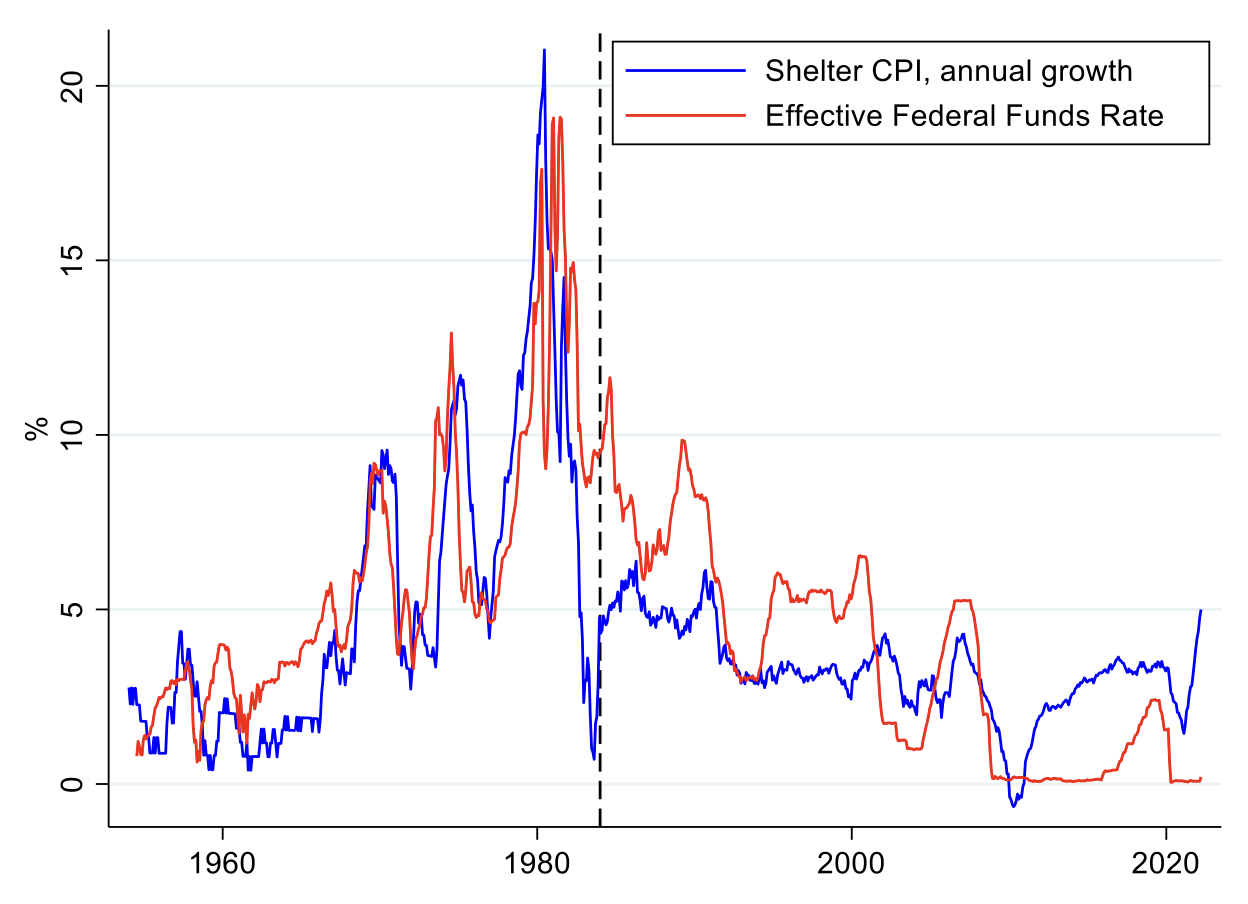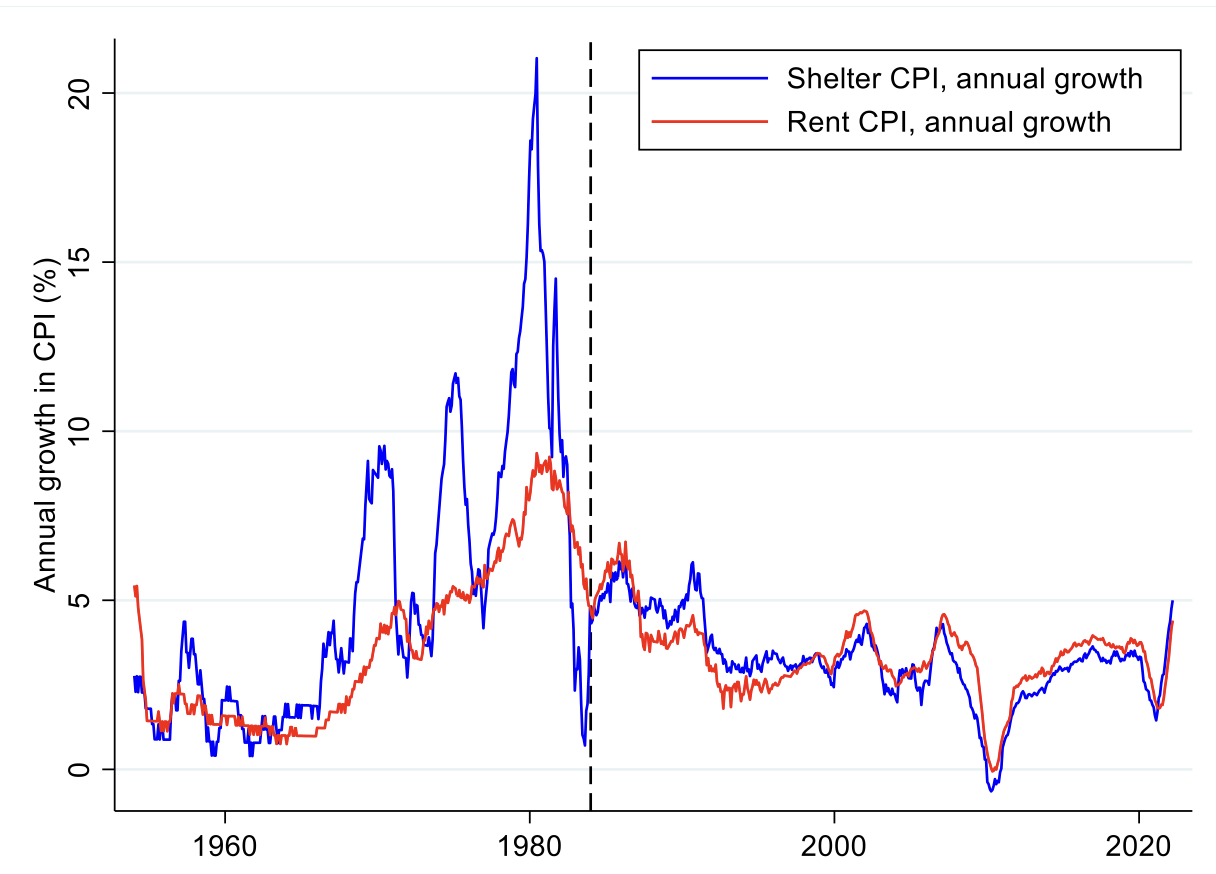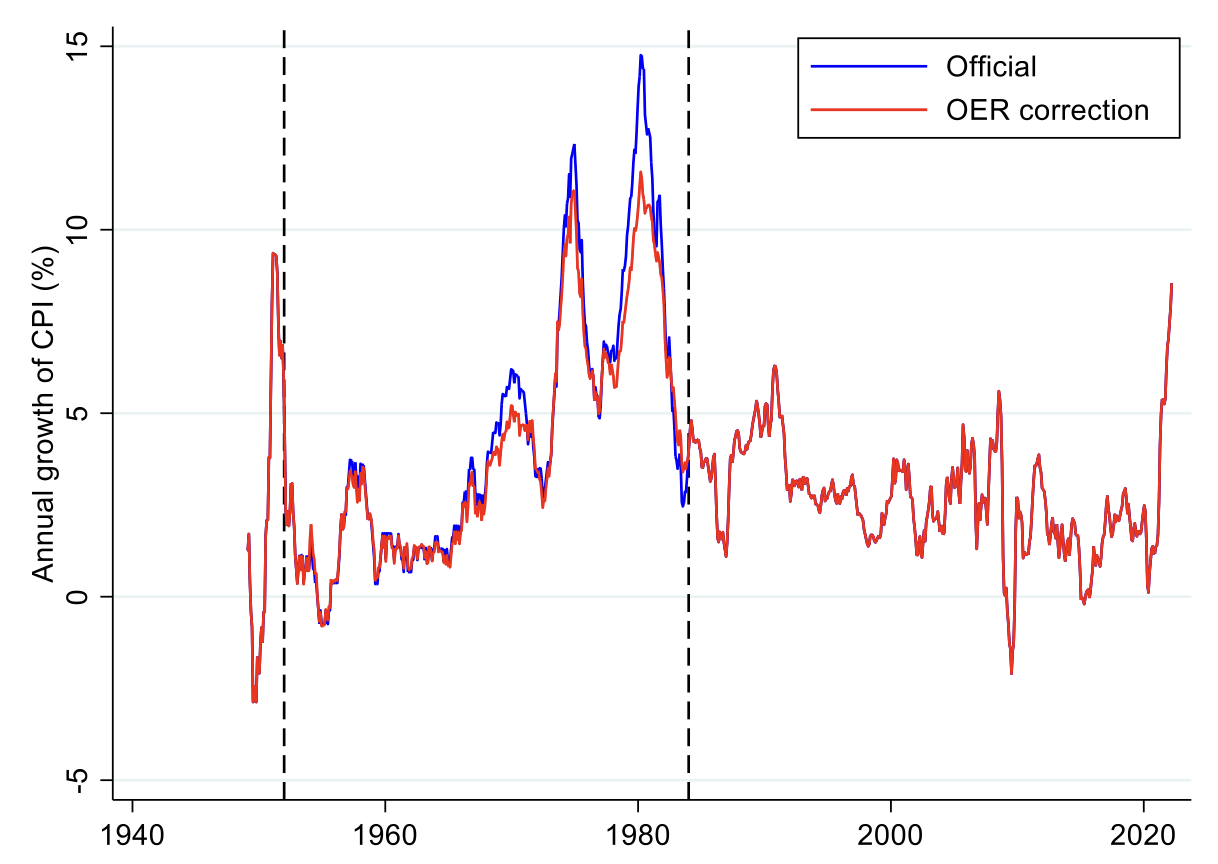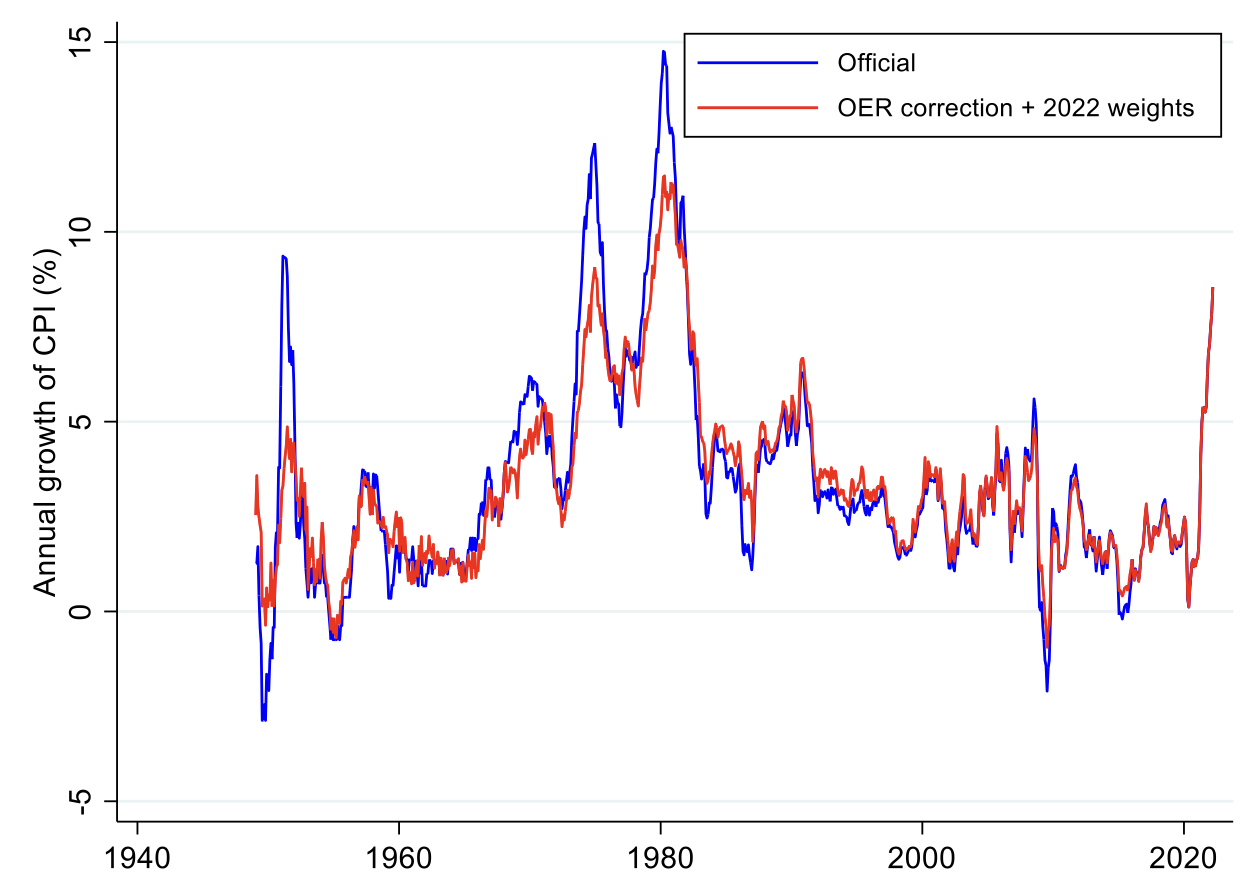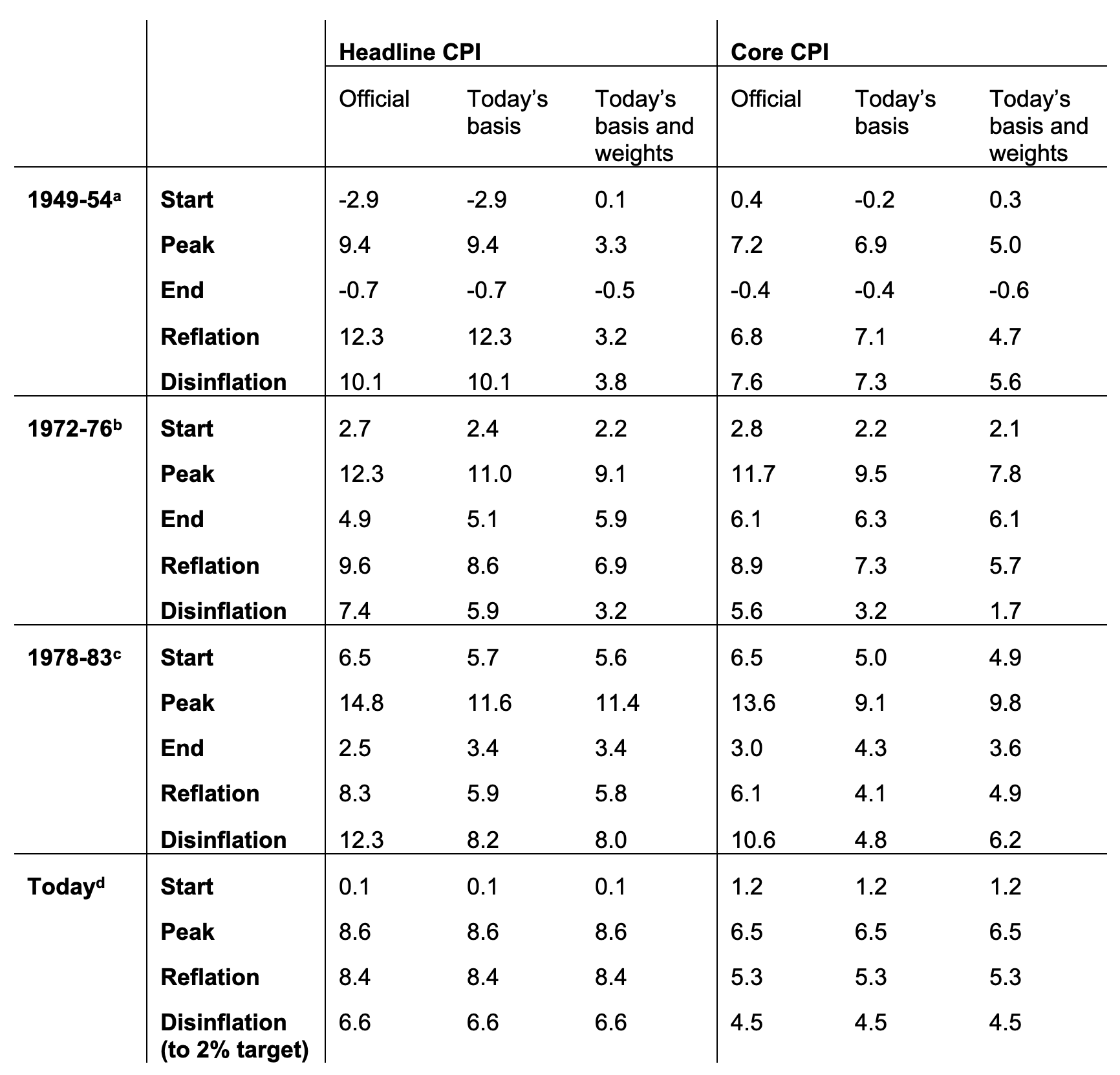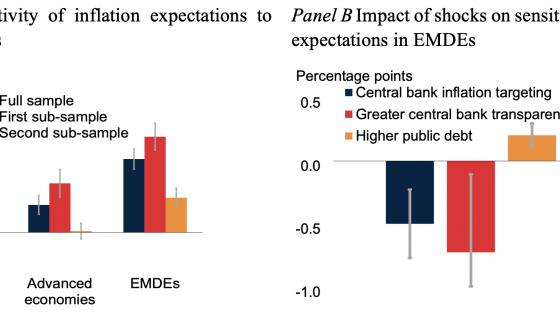As concerns about inflation have grown in the US, the monthly Consumer Price Index (CPI) has come under close scrutiny. The CPI grew 8.6% in the twelve months ending in May, the highest annual growth since 1981. This may not be the peak as traders now expect this rate to grow over the next four months to around 9%.1 A worrying number, it would still remain far below the official March 1980 peak of 14.8%. To think through today’s tightening inflation dynamics and monetary policy, economists are re-examining Volcker-era inflation and previous periods of elevated inflation (Reis 2021, DeLong 2022, Ha et al. 2022). In a recent paper (Bolhuis et al. 2022b), we caution against quick comparisons by pointing to important differences in measurement. The way homeownership costs were measured in headline CPI before January 1983 makes past peak CPI inflation measures, especially during the Volcker-era, look artificially high. Estimating CPI before 1983 using today’s methods reveals that current inflation, especially core inflation, is considerably closer to previous peaks than it appears at first glance. Attending to methods also reveals that previous measurement of shelter inflation was mechanically responsive to Federal Reserve interest rate policy. Plans for decelerating inflation therefore cannot rely on comparisons to the pre-1983 period of the CPI.
Even though historical CPI inflation looks more similar to today’s following adjustment, we stress some important differences with the Volcker-era. Today’s problems are more manageable for a few reasons. Most importantly, in the late 1970s long-run inflation expectations reached levels close to double-digits (Hazell et al. 2020). Current expectations remain well-anchored (Krugman 2022), which suggests that the inflation problem might be more easily resolved if it is dealt with promptly. Additionally, the main issue that we highlight does not affect the Federal Reserve’s preferred measure of inflation, the Personal Consumption Expenditure (PCE) Price Index (Wilcox 2022). The lower share of housing in the PCE should also allow for a swifter return to trend (Bolhuis et al. 2022a).
Measuring inflation: The role of housing
Housing is both a consumption good and an investment. Between 1953 and 1983, the Bureau of Labor Statistics (BLS) valued homeownership costs for the CPI without disentangling these two qualities. It produced a measure that broadly captures changes in the expenses of homeowners, taking house prices, mortgage interest rates, property taxes and insurance, and maintenance costs as inputs. Much more than rents, this estimate was responsive to changes in interest rates and fluctuations in home prices. This approach produced a volatile shelter series pre-1983, as shown in the top panel of Figure 1. This flawed measure received a full 26.1% of the weight of headline CPI in December 1982. These shelter costs were also directly affected by Fed policy, due to the federal funds rate’s effect on mortgage rates. During the tightening cycles in the 1967–1969, 1972–1974, and 1977–1981 periods, shelter inflation increased sharply, only to fall precipitously when the pace of tightening slowed down.
Figure 1 Shelter CPI inflation and the Federal Funds Rate, 1954 to present
Source: Bureau of Labor Statistics.
Notes: Percent change from 12 months earlier. Change in OER initiated January 1983.
In 1983, after ten years of internal debate, the BLS exchanged homeownership costs for owners’ equivalent rent (OER). By estimating what a homeowner would receive for their home on the rental market, the BLS stripped away the investment aspect of housing to isolate owner-occupiers’ consumption of residential services. Since this 1983 shift, shelter CPI has been much less volatile and much more correlated with rent CPI (bottom panel of Figure 1). Using publicly available BLS data for the post-war period, we develop new estimates of CPI headline and core inflation that can be better compared across time.
Our dataset contains 32 components that cover around 90% of the overall CPI since 1946. We construct three measures of inflation, presented in Figure 2. First, we replicate the official headline and core CPI inflation rate.2 We then adjust CPI inflation pre-1983 by estimating OER using the CPI rent series.3 Finally, to assess the importance of differences in the volatility of CPI components for overall inflation, we create a second version of the estimated CPI series that uses 2022 weights over the entire period and adjusts the pre-1983 data with estimated OER.
Figure 2 Official and estimated headline CPI
Source: Bureau of Labor Statistics, authors’ calculations
Notes: Percent change from 12 months earlier. Left-hand side: Homeownership costs are replaced with estimated OER pre-1983. Right-hand side: Homeownership costs are replaced with estimated OER pre-1983 and quantity weights are fixed at 2022 levels.
Comparing inflationary cycles
Our estimates suggest that the current inflation rate is closer to the peak of other cycles than the official CPI data suggest. In Table 1, we use our estimates to compare today’s inflation dynamics to the three inflationary cycles in which the annual growth rate of official headline CPI peaked above the current reading of 8.6%. The peak of the Volcker-era inflation (March 1980), currently understood to have been at 14.8%, is only 11.6% when adjusted for the switch from home ownership costs to OER. The growth in core CPI in the same month falls from 12.5% to 6.7% when measured using the OER method. These large differences reflect both the substantial weight of OER in the index, especially in core CPI, and the lower peaks of estimated OER relative to home ownership costs.
Table 1 Past inflation cycles and today
Sources: Bureau of Labor Statistics, Authors’ calculations
Notes: We define ‘Start’ and ‘End’ as the local minima of official annual headline CPI growth at the start and end of each cycle. We define ‘Peak’ as the local maximum of official annual headline CPI and core CPI growth for each cycle. For official core CPI, we use the CPI less food series for the period before 1958. Today’s basis: Homeownership costs are replaced with estimated OER pre-1983. Today’s basis and weights: Homeownership costs are replaced with estimated OER pre-1983 and quantity weights are fixed at 2022 levels. a Start: July 1949. Peak: February 1951 for headline and June 1951 for core. End: October 1954. b Start: June 1972. Peak: December 1974 for headline and February 1975 for core. End: December 1976. c Start: April 1978. Peak: March 1980 for headline and June 1980 for core. End: July 1983. d Start: May 2020. Peak: March 2022 for both headline and core.
Our estimates also indicate that past inflation cycles look more volatile than today’s due to the greater weight of transitory goods components in past measurements. In the early 1950s, for example, food and apparel accounted for almost 50% of the headline CPI index. After the growth rate of these components shot above 10% due to Korean war-induced shortages, headline inflation fell from 9% to 2% within a year. Today, however, food and apparel only receive 17% of the weight of headline CPI. The index bears witness to this shift from transitory goods components to less volatile services, with ‘sticky’ industries gaining weight in the CPI across the board (Bryan and Meyer 2010). The current approach renders housing inflation particularly sticky (Bolhuis et al. 2022a). Such changes in measurement methods complicate comparisons between CPI rates.
We note again that the Federal Reserve’s preferred measure of inflation since 2000 is the PCE price index, which has measured rent inflation consistently and does not suffer from the housing issue that we examine. Despite its shortcomings, the BLS recently reported that over 2 million workers were covered by collective bargaining agreements which tied their wages to the CPI. The CPI index also affects the incomes of almost 80 million people because of statutory action: 47.8 million Social Security beneficiaries, about 4.1 million military and Federal Civil Service retirees and survivors, and about 22.4 million food stamp recipients. The CPI is also used as an input for myriad other contracts in the US that will touch nearly every American household. In this way, a slower than desired decline in the CPI could become self-reinforcing in the CPI and PCE as inflation takes more time to exit the system. In addition, we note that the public and journalists tend to look first to the CPI for the current state of inflation. We leave the role of measured CPI and PCE inflation in forming long-term inflation expectations for future exploration, but caution against ignoring the CPI completely.
Takeaways for today’s inflation debate
Previous inflationary cycles look more volatile and responsive to Fed policy due to differences in how housing inflation was measured before and after 1983. We highlight three implications. First, our observations indicate that the current inflation regime is considerably closer to that of the late 1970s than it appears if inflation rates are compared straightforwardly. Our corrected estimates suggest that core CPI inflation is now at levels experienced in 1979. Second, we conclude that it is misplaced to glean the effects of monetary tightening from the published CPI disinflation Paul Volcker achieved in the early 1980s. Volcker’s rate of core CPI disinflation is significantly slower when measured using today’s methods. At the speed achieved in the 1980s, using this corrected estimate, it would take today’s headline CPI about three years to return to 2%. Finally, many commenters have said that monetary policy works through housing – that was clearly the case in the past. Once rates stabilized shelter inflation plunged mechanically. Today, given the lag structure of shelter inflation discussed elsewhere (Bolhuis et al. 2022a), residential services are likely to be a significant hindrance to declines in headline and especially core inflation. This could be a headache for the Fed even after housing prices stop rising at double-digit rates.
Authors’ note: Monthly estimates publicly available here. Please cite using the NBER working paper. The views expressed herein are those of the authors and do not necessarily reflect the views of the, IMF, its Executive Board, or IMF management.
References
Bolhuis, M A, J N Cramer and L H Summers (2022a), “The Coming Rise in Residential Inflation”, NBER Working Paper No. w29795.
Bolhuis, M. A., Cramer, J. N., & Summers, L. H. (2022b), “Comparing Past and Present Inflation”, NBER Working Paper No. w30116.
Bryan, M and B Meyer (2010), “Are Some Prices in the CPI More Forward Looking than Others? We Think So”, Economic Commentary (2010-02).
DeLong, B J (2022), “America's Macroeconomic Outlook”, Project Syndicate, 25 March.
Ha, J, M A Kose, H Matsuoka, U Panizza and D Vorisek (2022), “Anchoring Inflation Expectations in Emerging and Developing Economies”, VoxEU.org, 14 July.
Hazell, J, J Herreno, E Nakamura and J Steinsson (2020), “The slope of the Phillips Curve: evidence from US states”, NBER Working Paper No. w28005.
Krugman, P (2022), “Wonking Out: How Low Must Inflation Go?”, New York Times, 3 June.
Reis, R (2021), “Losing the inflation anchor”, Brookings Papers on Economic Activity.
Wilcox, D (2022), “US INSIGHT: Summers Is Right on CPI. Happily, PCE Is Fed Focus”, Bloomberg Intelligence, 7 June.
Endnotes
1 https://www.marketwatch.com/story/u-s-inflation-expected-to-keep-running-hot-traders-see-4-straight-months-of-roughly-9-or-higher-cpi-readings-11655399963
2 To ensure our bottom-up estimate of official CPI equals the published series, we add a residual CPI component.
3 We ‘backcast’ what we think that measures of OER would have been pre-1983 had the post-1983 method been used. We do this by regressing OER on rental inflation post-1983. For 1979 to 1983, we check our estimates against the retroactive series of the BLS that measures CPI inflation consistently using current methods.




